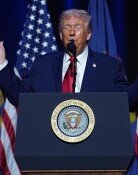Decrease of Wholesale and Retail in 50 Months
Decrease of Wholesale and Retail in 50 Months
Posted March. 28, 2003 22:17,
The wholesale and retail sales were decreased first in 50 months last month and facility investment has been shrinking consecutively during last two months.
The business indexes including leading, coincident and lagging indicators are sliding down altogether. The cut-down of those 3 indexes at the same time is first in 1 year and 10 months so far.
According to the trend of industrial activities in February, released on Mar.28 by the Korea National Statistical Office, the index of wholesale and retail sales were decreased by 1.8% as compared to that of the same month of last year. Those wholesale and retail sales had been rising until that time since recorded 3.6% decrease in December 1998 when the business was at its bottom level right after foreign exchange crisis.
▽Accompanying sluggishness of consumption and investment = Wholesale and retail sales were down by 0.2% and 7.4% respectively excluding 9.4% increase in sale of automobiles and fuel for vehicles.
Especially, the sales by discount stores dipped down by 12.4% for the first time since that statistics were made from 1995, which had shown the growth rate of double digits all the time until that time.
The sales growth rate of department stores recorded -1.3% in November and -13.8% in December of last year, and 10.2% in January and -13.7% in February of this year. Those rates are indicating a long-term dullness in the coming months.
Following the stagnant sales, the shipment of domestic consumption goods also decreased by 2.3%. On the contrary of increase in those of automobiles, projection TV, notebook and cigarettes, those of refrigerator, kimchi-refrigerator, water-purifying set, books and cosmetics were shown the decrease.
Mr. Shin Sung-woo, chief of industrial trend section in the Korea National Statistical Office explained, Aside from the slackness of consumers` psychology, the shift of new year day in Lunar calendar from Feb. last year to Jan. this year also affected much the reduction in sales amount over-all. The facility investment decreased by 4% as compared to the same month of last year, mainly following to decrease of the investment in communication devices and computers. The facility investment dipped by 7.7% in January, the biggest since September of 2001 and consecutively below zero for 2 months.
On the contrary, construction investment has been active, showing 9% in actual construction and 44% growth in contract amount respectively.
▽Across-the-board decrease of business indicators = Among business indicators, all of three indicators such as leading, coincident and lagging were shown 0.3%,0.1% and 0.5% decrease respectively.
Although too early to conclude, considering drop-down of coincident indicator for the first time since July last year and lowing down for 10 months of the growth rate of leading indicator over the same month in the previous year, the official explained, The business cycle is likely to get into the phase of slow-down.
Business leading indicator includes 9 indicators changing prior to general business such as facility investment and stock price index, coincident indicator includes 7 indicators moving concurrently as actual business such as production, export and wholesale and retail sale, finally lagging indicator includes 6 indicators following after general business such as inventory and consumers` expenditure.
The shift of the new-year day in lunar calendar to January brought about low consumption and the active production due to the increase of operating days.
The production grew by 10.2% over the same month of last year contributable to semi-conductor(27.9%), automobile(25.5%) and machinery and equipment(19.3%) sectors. The shipment went up by 6.6% in domestic consumption and by 10.6% in exports. The average operating ratio in manufacturing sector was shown 77.8%, up by 0.3% over January this year and 1.4% over February last year.
Kwang-Am Cheon iam@donga.com







